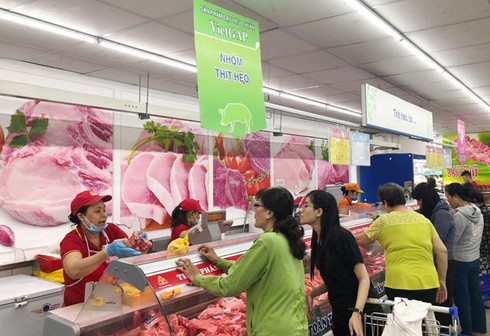 |
As a result of the move, the prices of live pigs in the northern region fell to between VND88,000 and VND93,000 per kilo on June 15, while those in the central region fluctuated between VND84,000 and VND91,000 per kilo.
Elsewhere, the prices of live swine in the southern region hovered around VND87,000 and VND93,000 per kilo, while Dong Nai province, a southern husbandry centre, saw the price of live pigs drop sharply to VND87,000 per kilo.
It is anticipated that the falling prices will continue into the coming weeks when the import of Thai pigs grows massively. Despite this, many local people remain concerned that the import of live pigs may serve to increase the risk of a reoccurrence of the African swine fever.
Pham Van Dong, director of the MARD’s Department of Animal Health, said the plan aimed at importing live pigs was originally deployed late last year, and Thailand was the only country that provided sufficient documents for Vietnam to fully assess the risks of importing live pigs from the market.
Nguyen Van Trong, deputy director of the MARD’s Department of Livestock Breeding, revealed that a number of businesses have registered to be able to import live pigs, one of whom plans to import between 100,000 to 200,000 pigs. In addition, the selling price of live swine will not be publicised, but the figure will hover at around VND50,000 per kilo.
According to several local firms, since Thailand granted permission for the export of live pigs to the country, the price of its live hog nationwide has increased.
Pham Tran Sum, Director of Hanoi-based Viet Duc International Nutrition Company, one of the main importers of live pigs from Thailand, said that the past three days has seen the price of live swine in Thailand rise by VND8,000 VND per kilo to over VND60,000 per kilo following a surge in demand.
Sum expressed concerns regarding the sharp rise in the selling price of imported pork, which could reach VND80,000 kilo in the local market due to the various costs that exist in terms of transportation and taxation.
According to the MARD, the total figure for imported pork during the first five months of the year reached more than 67,638 tonnes, representing an annual increase of 298%, with the majority of imports coming from Canada, Germany, Poland, Brazil, the United States, Spain, and Russia.
A business representative also expressed his hope that the boost in imports from Thailand will serve to reduce domestic pork prices, noting that imported pigs from the neighbouring country will not lead to major changes due to the supply source of pigs back in Thailand remaining limited.
Deputy Minister of Agriculture and Rural Development Phung Duc Tien forecast that pork prices will continue to fall due to a sufficient supply source locally, the restocking of herds nationwide since June, and the import of frozen pork. VOV